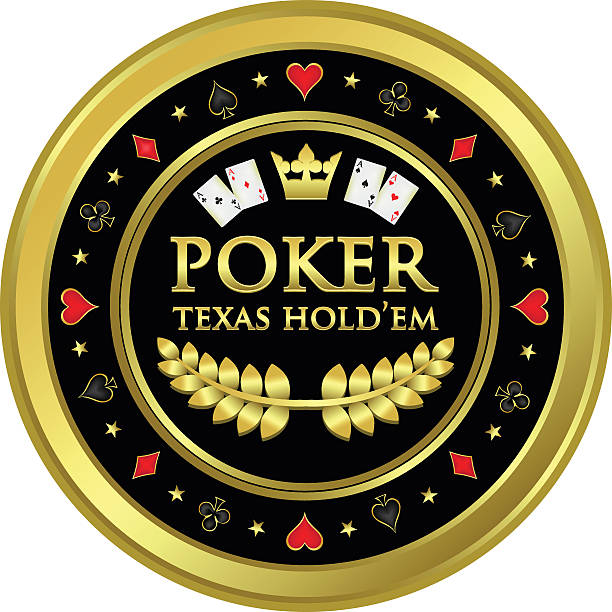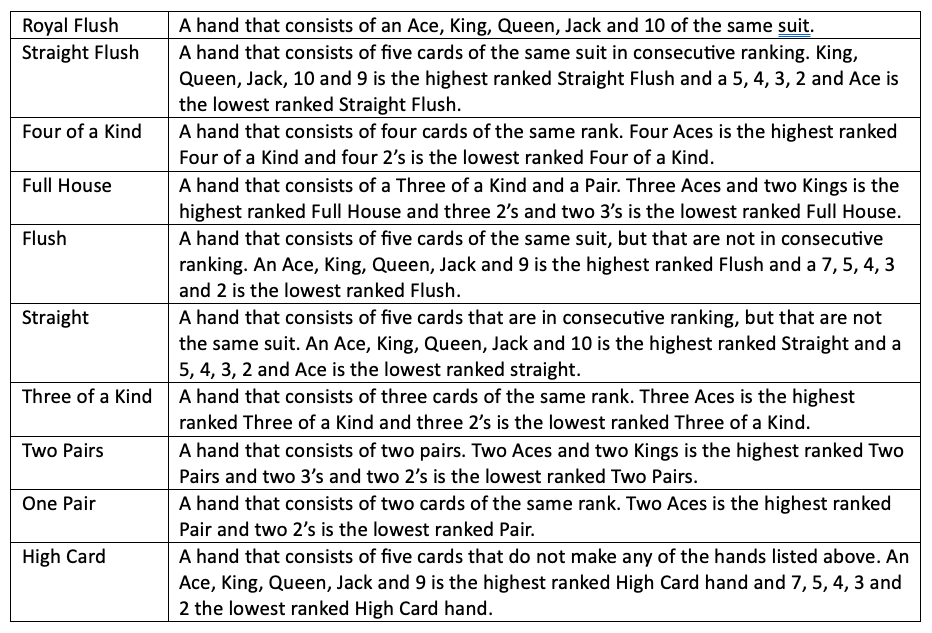
(GEGR-000852, GEAR-000293)
Object of Game
The object of the game is for players to form a five-card poker hand that ranks higher than the other players’ five-card poker hands. Each player may use any combination of the two cards initially dealt to them at the beginning of the game, referred to as “hole” cards, and the five cards dealt on the table throughout the course of the game, referred to as “community” cards or “the board” cards, or they may play the board by using no hole cards and using the five community cards, to make the highest ranking five-card poker hand, according to the rankings as shown below.
How to Play
To begin the game, the house dealer will designate which player is in the dealer position, indicated with a “dealer button”, for that hand according to house rules. The house dealer will then instruct the two players immediately to the left of the player who received the dealer button to post the “small blind” and “big blind” respectively. The “small blind” and “big blind” are mandatory, predetermined wagers according to the wagering limits of the game being played, used to initiate action. The dealer position, small blind and big blind shall rotate from player to player around the table clockwise after each round of play. The player with the dealer button is the last to receive cards and has the right of last action on all rounds of play except the first round, in which the big blind shall have the right of last action. On all subsequent wagering rounds (second, third, and fourth), the action is started by the first active player to the left of the dealer button.
Once the dealer position has been established and blinds have been placed, the house dealer shall deal one card face-down to each player, starting with the player to the left of the dealer button, clockwise around the table until all players have two cards face-down. These initial two cards are referred to as “hole cards.” Once each player has received their two hole cards, the first round of wagering will occur. Players are given the following options, starting with the player to the left of the player that received the big blind button and continuing clockwise around the table:
(A player who folds their hand will no longer participate during that round of play)
During the second, third, and fourth rounds of betting;
After all players have acted in turn and either called all wagers or folded their hand, the second round of wagering will begin. The house dealer shall present three cards face up on the table, which is referred to as “the flop.” These are community cards and are shared by all players. All active players, which are players that called all wagers and have not folded their hand, will have the same options as listed above.
After all players have acted in turn either called all wagers or folded their hand, the third round of wagering will begin. The house dealer shall present one card face-up on the table for a total of four community cards on the table. This is referred to as “the turn card.” This card shall also become a community card and is shared by all players. All active players, which are players that called all wagers and have not folded their hand, will have the same options as listed above.
After all players have acted in turn either called all wagers or folded their hand, the fourth round of wagering will begin. The house dealer shall present one card face-up on the table for a total of four community cards on the table. This is referred to as “the river card.” This card shall also become a community card and is shared by all players. All active players, which are players that called all wagers and have not folded their hand, will have the same options as listed above.
At the end of each round of wagering, the dealer will place all chips wagered into the middle of the table referred to as “the pot”. Each player may only win up to the amount in which they have wagered from other active players during that round of play. Any wagers made by other players more than the wagers made by the original player will be collected and placed in a second pot referred to as a “side pot”. Subsequent pots will be made for each player if needed based on the amounts wagered.
Determining a Winner
Once all rounds of betting have been completed, all active players shall then enter into a showdown with each other and compare their hands. The house dealer will start with the remaining active players in the last pot (most chips wagered) determining which player wins the pot according to the card values and hand rankings below. This process will occur all side pots and main pot, until all pots have been awarded to the winning player(s).
Card Values and Hand Rankings
The rank of each card used in Texas Hold’em when forming a five-card high poker hand, in order of highest to lowest rank, shall be: Ace, King, Queen, Jack, 10, 9, 8, 7, 6, 5, 4, 3, and 2. All suits shall be considered equal in rank. Ranking of hands for Texas Hold’em, in order from highest to lowest rank are:

Bad Beat Progressive Jackpots:
